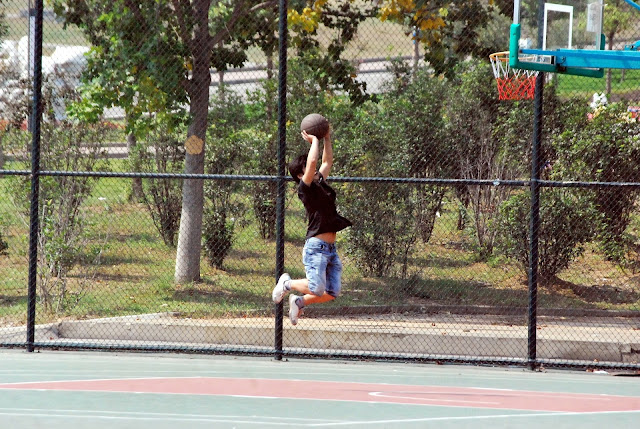The big question, is how to increase vertical leap? Is that even possible?
When you start a story about jumping and dunking, you
usually think of specific exercises or certain muscle groups. But first, we
need to determine whether the athlete uses more strength or speed when
jumping.
After identifying the weak link we can talk about specific
exercises and other details to improve jumping higher.
Speed and strength both are important because jumping is an
explosive movement. Explosiveness is defined as Speed x
Strength by using this information you can determine how to jump higher and dunk
One way to improve the jump is to either increase strength or
increase speed or improve both characteristics.
The ability to jump higher may have something to do with natural
talent, but much more often it is simply the result of regular and dedicated
exercise.
Regular training is needed to make progress in any field, this
is no exception.
Following Methods to jump higher and dunk:
The way to
improve higher dunks is to identify the part that needs improvement which can
be achieved by performing a simple test
Performing a test:
There is a test that can determine whether an athlete is
dominant in strength or speed while performing a high jump during
dunking.
This test is performed by first checking the jump from a static
position (the athlete goes to the jump position and stays there for 2-3
seconds, after which he jumps up without swinging and further squatting).
The second part of the test involves a normal jump without
ceasing and with arm swings.
Results:
When the results are obtained, it is necessary to compare them
and see the difference.
If the jump from the static position is equal to the normal
jump, it means that strength is the dominant characteristic of the athlete. In
that case, the athlete will benefit more from performing plyometric
exercises increasing the speed and explosiveness.
If the athlete jumped more from a normal jump than from a static
one, it means that he relies more on impulse and speed. In that case, athletes
need more exercise in training to develop strength.
Based on that, choosing exercises and compiling programs is much
easier. Now let’s go to the exercises.
Plyometrics, or plyometric exercise:
Originated in the Soviet Union as the result of very serious
research at the national level. Their goal is primarily to gain speed and
strength, and they are used in a whole range of sports.
In short, this way of training performs a shock on the target
muscles and thus provides the release of force, result of which is greater
performance in speed and jump.
The basic plyometric exercise would be to ‘fall’
from a step-elevation to the surface.
The athlete stands on an object that is high of about 30-50 cm
and performs a "step into the void" to be land on both feet at the
same time.
Since it is an elevation and the Earth's gravity acts during
that fall, the muscles will suffer quite a shock when landing. However, the
main goal of the fall is primarily an explosive high jump immediately after
contact with the ground.
It is between these two contractions (during the fall and during
the jump) that the above-mentioned force is released, all in accordance with
the formula F = m x a.
The higher the velocity between two contractions, the greater
the effect. This exercise science is huge and deserves its own article.
Bring smoothness:
Flexibility will work wonders in improving the dunking power
strength training alone will not be enough to result.
Contraction and expansion of muscle must be quick to give you
the explosive moment you need to make higher jump hence flexible muscles .
A flexible body not only will help in jumping higher but long
jelly arms will increase the upward momentum making you dunk even further.
Develop leg muscles:
The lower limbs are the source of the power of the jump; the
stronger they are, the more you can push upwards to reach the maximum jump
reach.
The types of exercises you can do depend on the equipment you
have available:
A perfect example is squats, which can be performed without anything or
with some equipment. To do them, you simply have to stay standing with your
legs spread shoulder-width apart, then you have to lower your body to the
ground keeping your back straight and your knees bent at 45 °, just as if you
wanted to sit on a chair.
Return to an upright position and repeat the exercise. To
increase the intensity, you can use weights that need to be carefully increased
as you become stronger.
Stand up straight and take a step forward keeping your back
straight and your knee bent at 45 ° if you want to make the exercise more
demanding, take a longer step.
Return to an upright position and repeat, remembering to
alternate legs.
You can make the exercise more tiring by using weights that need
to be carefully increased as your resistance improves. This will make your
lower back and leg muscles stronger.
Before using any exercise equipment, consult a professional to
find out how to use it properly.
Visit here to get the training for jumper higher training for dunking
The technique and benefits of exercise:
Work on the technique and bring the movement as close
as possible to the ideal.
The technique is crucial in every physical endeavor, so it is
the same with jumping. When the technique is adjusted and the movement itself
is brought as close as possible to the ideal.
A number of negative factors that reduce the jump by even a few
centimeters are rejected.
Exercise can lead to perfectionism so that the jump in any
situation begins to look harmonious and its height is always above average.
Recording progress, taking notes will improve your practice and
correct your mistakes.
To make things easier use a smaller Rim height to feel better
just to make you motivated to play and practice the dunks.
Listen to your body:
This is life advice, not sports only. If something hurts, stop,
rest, or reduce the intensity. Pain is a warning and the body sends us a
message that something is wrong.
Now when you have all information needed, there is no excuse, go out there give everything you have, and finally, start dunking like never before.
Summing Up:
- Performing a test
- Plyometric exercise
- Bring smoothness
- Develop leg muscles
- Listen to your body








